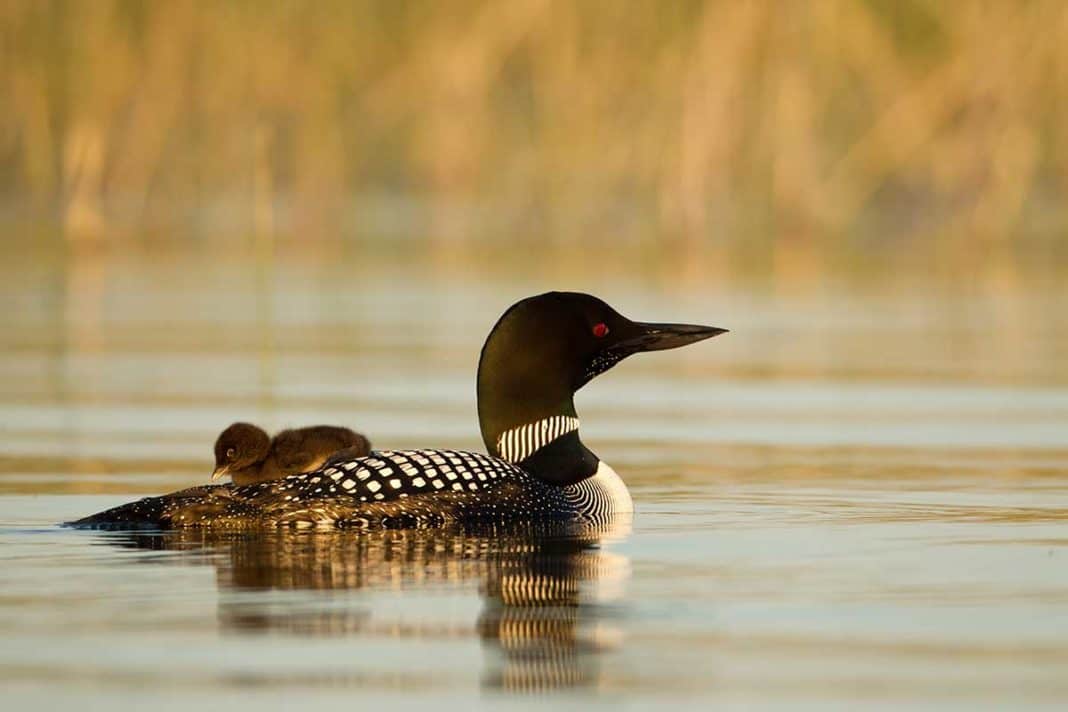Common loon chick production is declining
CANADA – Common loons are an iconic Canadian bird, but loon chick production is declining.
Volunteers are needed to participate in the Canadian Lakes Loon Survey (CLLS). Participants will monitor loon chicks by visiting a nesting area at least three times over the summer. Information collected by participants helps track the reproductive success and assesses the long-term health of common loons and the lakes they depend on.
Loons are good indicators of healthy lakes and can tell you a lot about local watersheds. “If loon chicks don’t survive, that’s a red flag about the health of a lake,” said Kathy Jones, volunteer manager for Ontario programs and the CLLS with Birds Canada. The survey is one of the oldest bird surveys in Canada. It was launched in 1981 following the discovery of dead lakes in central and Northern Ontario, especially in the Canadian Shield and Sudbury-Nickel Belt areas, caused by acid rain, and quickly became a national research program. It assesses common loon reproductive success at different scales and can point to links between habitat and reproductive success. Since 1981, more than 4,000 participants have monitored breeding common loons on 4,500 lakes.
Recent studies suggest increases and decreases in loon reproduction occur over a 10-year pattern. A recent study for the United States Fish and Wildlife Service suggests a minimum of six years of data is needed for a single lake. “Population levels do cycle,” said Ms. Jones. “We know that there has to be 0.48 chicks per pair per year to keep the population stable. Often only one of two chicks will survive but that’s okay if half of the chicks survive per year over time. Right now, there are some concerns. Loons are raising fewer chicks and are getting close to that 0.48 lower limit. It’s still above 0.48 across Canada but the next few years will be very important to follow.”
Loon surveys can be conducted during typical lakeside activities such as fishing, swimming, boating or just relaxing by the shore. It’s very easy to participate in the study, Ms. Jones said. Participants sign up and report data online. High school students can even obtain volunteer hours by participating. “The classic hatch time is July 1, so they would begin nesting around June 1. Survey participants watch their lake in June for signs of nesting, in July for chicks and once more in August to see whether the chicks have survived long enough for their first flight.”
“It’s not a huge commitment. Both solo bird watchers and families can really get into loon watching but the survey only asks about nests. Loons are big birds. They’re easy to see.”
She recommends using a pair of binoculars or a scope to keep an eye on the adults and chicks but reminds everyone to ensure they follow any required COVID-19 protocols. Training materials get sent to participants by Birds Canada upon registration.
Breeding pairs of common loons are very loyal to nesting sites and often come back to the same ones. “It’s fun to watch,” Ms. Jones said. “We used to think it was always the same pair that came back but have learned that sometimes the birds are displaced by territorial disputes. Also, loon divorces are a thing; males will come back to hold their territory if they can but could be challenged by another male. Females are more likely to bail in a territorial dispute. Loons don’t cross-gender fight: males will fight males and females tend to fight other females. Fights tend to happen later in the year. It’s possible that males watch and see which nests survive and where chicks thrive, waiting until later in the year to scope out the good spots.”
There have been 11 lakes surveyed on Manitoulin Island, but only one recently. A survey was done on Smoky Hollow Lake in 2020. There was one at Long Lake in 2011 but the others date back to the 1990s. “It would be great to have data from Manitoulin again,” she said. “Surprisingly, there has never been a survey on Lake Mindemoya.”
Lakes generally need to be a minimum of 60 acres to support a breeding pair. It comes down to the runway, Ms. Jones explained. “Loons have to run a long way on the surface of the water in order to take flight. Manitoulin seems to have a lot of wind so that may shorten the length of runway needed. Other requirements are the size of the lake, available food sources such as fish and crustaceans and having available appropriate habitat for nesting. Loon nests almost float. Loons tend to nest in marshy areas and they’re not strong nest builders so shorelines with steep cliffs and sharp edges are not good habitats for nesting. It’s pretty easy to watch and find out.”
Breeding pairs are not likely to be found nesting on the shorelines of the Great Lakes or Georgian Bay because of inappropriate habitat and water level fluctuations. Non-breeding pairs may be found in these locations during spring and fall migrations if food is available. “Lake Huron is really an inland sea,” she continued. “Non-breeders could stay months there. They could possibly be young adults not ready to breed. It’s hard to know what’s out there. Typically, waterfowl surveys are only done at the edge of lakes and that leaves huge bodies of water available. Loons like to overwinter in nearshore regions, oceans. They could be there, in Lake Huron, but we don’t know about it.”
If you are seeing loons that are migrating non-breeders, Ms. Jones recommends that you record them at ebirds.ca to help keep track of the non-breeders.
Threats to the common loon include increased boating activity, water level fluctuations, contaminants and habitat loss. “Climate change also puts more stressors on the birds and the ecosystems they live in,” Ms. Jones said. “Citizen scientists are important to understanding these threats. There aren’t enough scientists to monitor the more than one million lakes across Canada.”
Register online to participate in the loon survey through the volunteer portal at birdscanada.org/birdmon/clls. The survey runs from May 24 to after the September long weekend, with data requested to be in by Thanksgiving.





